|
Doug Schneider Sunday, October 13
Today I came across two new products, both speakers, that
absolutely blew me away. One came from ViV Laboratory of Japan, while the other was from
Emerald Physics in the USA.
First, the Emerald Physics speaker. I'd heard of the
company's "controlled directivity" approach to loudspeaker design some time ago,
so I was intrigued to hear its effect at the RMAF. What I saw when I entered the room was
an interesting-looking speaker called the CS1, a two-way design that uses four 10"
bass drivers, two mounted on the front and two on the back. They operate in pairs in a
dipole configuration. When the top one on the front moves out, the corresponding one on
the back top moves in, and vice versa. The same goes for the bottom woofers. The advantage
of a dipole configuration is that because the woofers are moving out of phase, you get
cancellation to the sides, resulting in null areas that cause less side-wall reflection.
The higher frequencies (750Hz up) are reproduced by a front-mounted compression driver
that has a waveguide surrounding it to direct most of its output straight ahead -- again,
reducing wall reflections. In short, this is a speaker that directs most of its sound
directly at the listener. If that's not enough, it has an external digital crossover, so
you don't get the phase irregularities that you do with conventional crossovers. Total
price: $10,000 per pair on up, depending on finish. Yes, a lot of money -- but this seems
to be a lot of loudspeaker.
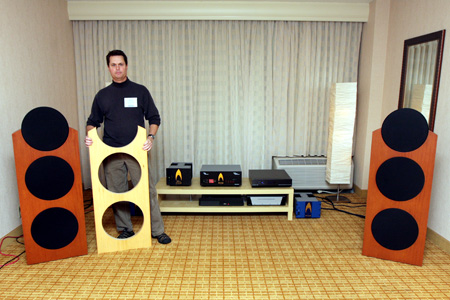
Clayton Shaw showing an alternate finish.
But all that technology amounts to nothing if the speaker
doesn't sound good. Suffice it to say, though, that the sound was every bit as impressive
as the technology -- so much so that we named this demo a
Standout. The clarity and purity were astonishing, yet the speaker had such a relaxed
sound that I could have listened to it for hours. Marc Mickelson was sitting in the best
spot and said the imaging was stellar. All in all, amazing, and all the more
impressive given that the speakers were being demonstrated in a small room.
Now the ViV Laboratory speaker. When I first heard about
this $60,000 single-driver speaker from some of our writers who were here, I thought it
would be a complete joke. Think about it: 60 large for a single-driver speaker! Who would
buy such a thing? Suffice it to say that I had to eat my words.
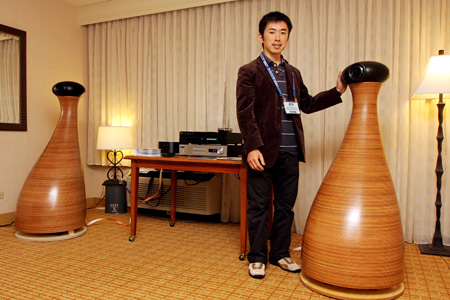
The Evanui Signature is the brainchild of Koichiro Akimoto
(above) who said the idea for it came to him one night in a burst of inspiration. The
horn-like cabinet is made from 63 layers of plywood that have been hollowed out in such a
way as to let the low frequencies build and escape. The finish of the wood is wonderful.
The top module is solid aluminum and houses a 3" full-range driver that -- get
this -- has no surround. But I'm not talking "no surround" like B&W
drivers have no surround. Rather, this driver floats in the speaker's head piece, allowing
the designer to simply pull it out.
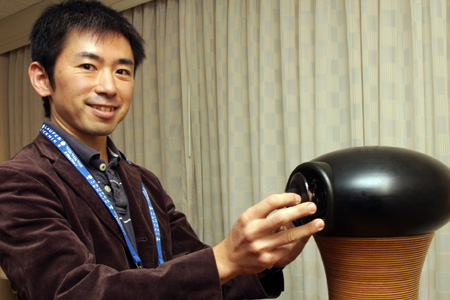
He showed us how the driver is decoupled from basket and
cabinet -- and anything around it. I don't know exactly how he does it, but it has
something to do with an oily substance that the driver is coated with and some method to
keep the driver aligned. There's no crossover whatsoever, and the designer says that this
driver extends upward to 30kHz -- "maybe higher, but I can't measure higher."
Really neat.
Most of the single-driver speakers I've heard are sonic
disasters, regardless of their prices. At best, they have a pretty midrange and great
transparency, but no highs and no lows. The Evanui Signature is different. It sounds, good
-- really good, in fact. Not perfect, mind you, but it has great midrange
transparency, impressive highs, and a generous level of bass that swells through the room.
It can also play impressively loud and, all in all, is completely unlike any other
single-driver speaker I've heard.
I think ViV Laboratory might really be on to something here
-- perhaps even something groundbreaking, not unlike Emerald Physics. Granted, $60,000 is
a lot of money for a single-driver speaker, but this one does seem special.
Emerald's Physics' CS1 and ViV Laboratory's Evanui
Signature are two of the most impressive products that I saw and heard this weekend --
heck, that I've seen this year -- and I'm writing about them here to let you know so you
can seek them out and hear them for yourself. After all, that's what show reporting is
supposed to be about. If you manage to hear them, pop me an e-mail and tell me what you think. Am I off my
rocker, or are they really as good as what I heard here in Denver?
Saturday, October 12
Yesterday I had a tough time coming up with something to
write about. Today there were two products I saw and heard that I couldn't shut up about.
One was the Audio Research VSi60 integrated amp and the other was the Vivid Audio B1
loudspeakers. I'll explain.
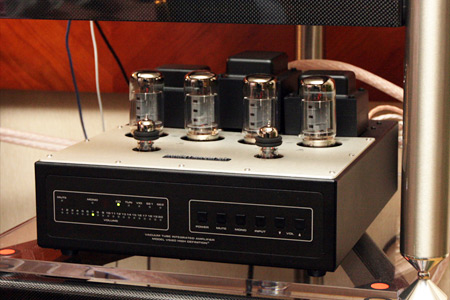
The ARC VSi60 is an all-tube integrated amplifier that the
company says will deliver 50Wpc into an 8-ohm load. At this show, I heard it driving a
pair of...
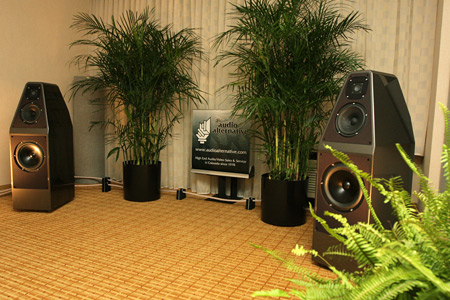
...Wilson Audio Specialties Sophia 2 loudspeakers, and the
sound was quite good, indicating to me that the VSi60 is a high-quality design. What
really got me excited about the VSi60 was the price: $3995. To me, that price combined
with ARC's build quality and sterling reputation can make this a significant product,
providing that the sound quality is as good as what I heard here in Denver. Frankly, what
the world doesn't need right now is more ultra-expensive products that only a
handful of people can afford. Instead, we need truly high-end, mid-priced products from
reputable companies that are relevant to the lion's share of the market. That's what the
VSi60 appears to be. I've always admired ARC's products, but I haven't had the urge to
review any. The VSi60 changes that.
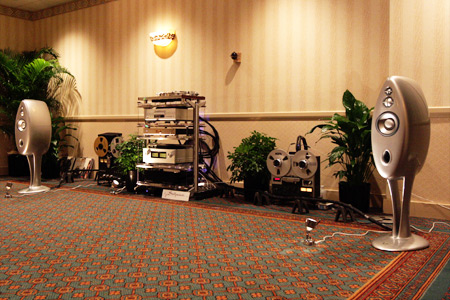
The other product that gave me a charge was the B1
loudspeaker from Vivid Audio, a company headquartered in South Africa. The B1 is a
four-driver, three-and-half-way design that features the company's proprietary drivers and
cabinet material (the website says, "complex-loaded carbon-fibre-filled
polymer"). The B1 also has a unique look. Most important, though, was that the
speakers sounded absolutely spectacular -- exceptionally clean and transparent and able to
throw a wickedly well-defined soundstage that was wall to wall. If I had to choose one
word to describe them, it would be outstanding.
The only downside to the B1 is the price: $15,000 per pair
-- not cheap. However, I've heard far more expensive speakers that didn't sound as good,
which makes me think that the folks at Vivid are really on to something with their unique
loudspeaker designs. Like the VSi60, I'd love to get my hands a pair of B1s to review.
Perhaps in time.
Friday, October 10
This was the first show I've been to where, after the first
day, I found it difficult to come up with something to say regarding what's its about --
the overall tone, the flavor of what's going on. Nothing stood out for me. Strange.
It wasn't until after dinner when I decided to go to a
movie -- Body of Lies, which just opened and stars Russell Crowe and Leonardo
DiCaprio -- when I realized one key thing about the 2008 Rocky Mountain Audio Fest: so
far, I've seen no home-theater displays.
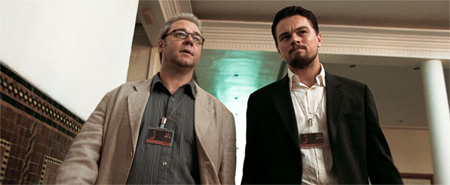
This is significant, but not because it's any kind of
bellwether that the home-theater market is dying -- far from it, it's still growing by
leaps and bounds and will continue to do so for as long as people like watching movies
(likely forever). It's significant because unlike in the past, when many manufacturers
thought they had to bring a least some home-theater equipment to a show like this one,
that's not case anymore. Two-channel hi-fi is alive and well and can quite happily sustain
an event the size of this one. Amps, preamps, speakers, turntables, and CD players are the
order of the day here, not projectors, processors and Blu-ray players.
Undoubtedly, some of the same companies that are displaying
here will bring their home-theater arsenal to CES in January, a broader and more
encompassing show, but the Rocky Mountain Audio Fest is clearly about audio, just as its
name indicates, and it will likely never become the Rocky Mountain Audio/Video Fest. To
see movies here, you'll just have to go the theater.
|

